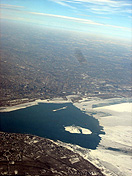Electronic Highways
Lifting the boom
While we enjoyed the sun and warm temperatures in our region during a mild month of March, much of the ice on Lake Erie melted. The Lake Erie-Niagara River ice boom will be removed early this year due to so much melt. Once again, it did its job by keeping large pieces and amounts of ice from flowing into the Niagara River.
Since 1964, an ice boom has been installed in the eastern end of Lake Erie to control the amount of ice flowing into the Niagara River. This boom on Lake Erie helps diminish potential damage the ice might cause to the shoreline and structures along the waterway. The boom also allows water to continue to flow to the hydro plants while keeping ice from blocking the water intakes.
Lake Erie’s boom is made up of a series of floating steel pontoons that span from the U.S. to Canada. Each pontoon is 30 inches in diameter and 30 feet long. The boom is located about two miles from the Peace Bridge.
Ice does form at the base of Niagara Falls each winter, but the boom helps prevent an enormous ice bridge from forming in the Niagara Gorge. Residents of this area may remember stories of people walking on the ice bridge. This has not been allowed since 1912, when the bridge broke up and three people were killed.
This year, there may not be much ice to see floating along the Niagara River, but take the time to visit a local park to catch a glimpse of ice or just to enjoy the waterfront. Front Park in Buffalo, the Erie Basin Marina and several parks along the Niagara River—Niawanda, Isle View and Gratwick—have good viewing areas. Watching the ice move through the rapids from either Goat Island or Niagara Falls is very impressive as well.
There is an annual weekend event to celebrate the lifting of the boom that includes a ball drop from the Peace Bridge, a shoreline cleanup by the Buffalo Niagara Riverkeeper organization, concerts and fireworks. This celebration occurs even if the boom has been lifted early.
Wherever ice booms are installed they are not without controversy. Climatic change, flooding, cost, maintenance, river bottom damage and water levels are common issues debated. The concerns of some in the Erie-Niagara region are not unique in comparison to other areas with booms.
Even if you do not get to see the Lake Erie-Niagara River ice boom in place this year, take this opportunity to learn about this boom and others. Visit the UB Libraries’ collections for additional information.
—Jennifer Frys, University Libraries


Reader Comments